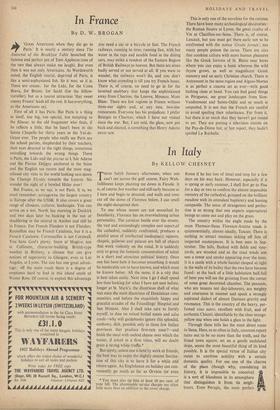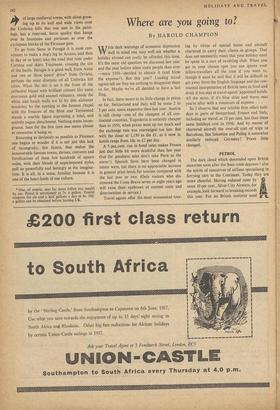In Italy By KELLOW CHESNEY T HESE harsh January afternoons, when
one can't see across the golf course, Fairy Wish- fulfilment keeps planting me down in Fiesole. It is, of course, hot weather and still early because as I turn and begin to descend, and walls and trees cut off the dome of Florence below, I can smell the night-dampehed dust.
To one whose senses' are not smoothed by familiarity, Florence has an overwhelming urban personality. The cornices beetle over the streets; the vast and astoundingly complex east aspect\of the cathedral, suddenly confronted, produces a painful sense of intellectual inadequacy; squares, chapels, galleries and palaces are full of objects that work violently on the mind. It is suddenly easy to grasp the fantastic concentration of talent in a short and atrocious political history. Once one has been here it becomes something it would be intolerable not to have known, and which must be known better. All the same, it is a city that is best taken easily. Next time I go I shall spend less time looking for what I have not seen before, longer at St. Mark's, the illustrious shell of what was once the most illustrious of Dominican com- munities, and before the exquisitely happy and graceful arcades of the Foundlings' Hospital and San Miniato. Also I shall take care to fortify myself, to dine on mixed boiled meats and salsa verde—why will guidebooks ignore this splendid, unshowy, dish, possible only in those few Italian provinces that produce first-rate meat?—and finish the meal with melted cheese over which the waiter, if asked in a firm voice, will no doubt grate a strong white truffle.* .
But surely, unless one is held by work or friends, the best way to enjoy the slightly sinister fascina- tion of this city is to leave it for a while and return again. An Englishman on holiday can con- veniently go south as far as Orvieto (or even * You must also tip him at least 10 per cent. of your bill. The abominable service charges are often little more than an addition to the cover, charge. Rome if he has lots of time) and stop for a few days on his way back. However, especially if it is spring or early summer, I shall first go to Pisa for a day or two to confirm the almost impossible memory of the cathedral, grouped on the brilliant meadow with its attendant baptistery and leaning campanile. The sense of strangeness and perfec- tion is so strong that one expects supernatural beings to come out and play on the grass.
The country within the angle made by the main Florence-Siena Florence-Arezzo roads is quintessentially, almost ideally, Tuscan. There is nothing to attract maniacs ticking off lists of inspected masterpieces. It is best seen in Sep- tember. The hills, flanked with fields and vine- yards, are wooded and as the road winds one sees a tower and smoke appearing over the trees. It is a castle with a whole hamlet clasped so tight in the walls of its bailey that the two have become fused: at the back of a little habitation half-full of hens you will see the groining from the corner of some great decorated chamber. The peasants, who are tenants not day-labourers, are weighty and courteous in manner and speak a strongly aspirated dialect of almost Dantean gravity and resonance. This is the country of the heavy, per- fumed vino santo, excellent with fruit, and of authentic Chianti, identifiable by the clear orange- yellow star when one holds a glass to the light.
Through these hills lies the most direct route to Siena. Here, as so often in Italy, common report turns out to be no more than the truth, and the broad town square, set on a gentle undulated slope, seems the most beautiful thing of its kind possible. It is the special virtue of Italian city states to combine nobility with a certain domestic quality. For me one of the charms of the place (though why, considering its history, it is impossible to conceive) 40 is a sort of blandness in its atmosphere that distinguishes it from its neigh- bours. Even Perugia, the most perfect Art #of large mediaeval towns, with olives grow- ing up to its wall and wide views over the Umbrian hills that one sees in the paint- ings, has a reserved, fierce quality that hangs over its fountains and porticoes as over the cyclopean blocks of the Etruscan gate.
To go from Siena to Perugia it is most con- venient to make a dog's leg to Arezzo, and then (a day or so later) take the road that runs under Cortona and skirts Trasimene, crossing the site of the battle. Perugia is a good walk from Assisi and two or three hours' drive* from Orvieto, perhaps the most dramatic of all Umbrian hill cities. When the sun is on it the front of the cathedral blazes with brilliant colours like some enormous gold and enamel reliquary, inside the white and basalt walls arc lit by dim alabaster windows; by the opening to the famous chapel with the frescoes of the Blest and Tormented stands a marble figure expressing a total, and entirely pagan, detachment. Nothing seems incon- gruous. Seen for the first time one seems almost to remember it being so.
Returning as deviously as possible to Florence one begins to wonder if it is not just this lack of incongruity, this fitness, that makes the innumerable famous towns, shrines, convents and fortifications of these few hundreds of square miles, with their blends of superimposed styles, pull so powerfully and lastingly at the imagina- tion. It is all, in a sense, familiar because it is one of the heart-lands of our culture.
• One, of course, sees far more (often too much) by car. Petrol is unrationed at 7s. a gallon. Tourist coupons for six and a half gallons a day at 4s. 10d. a gallon can be obtained before leaving UK.











































 Previous page
Previous page